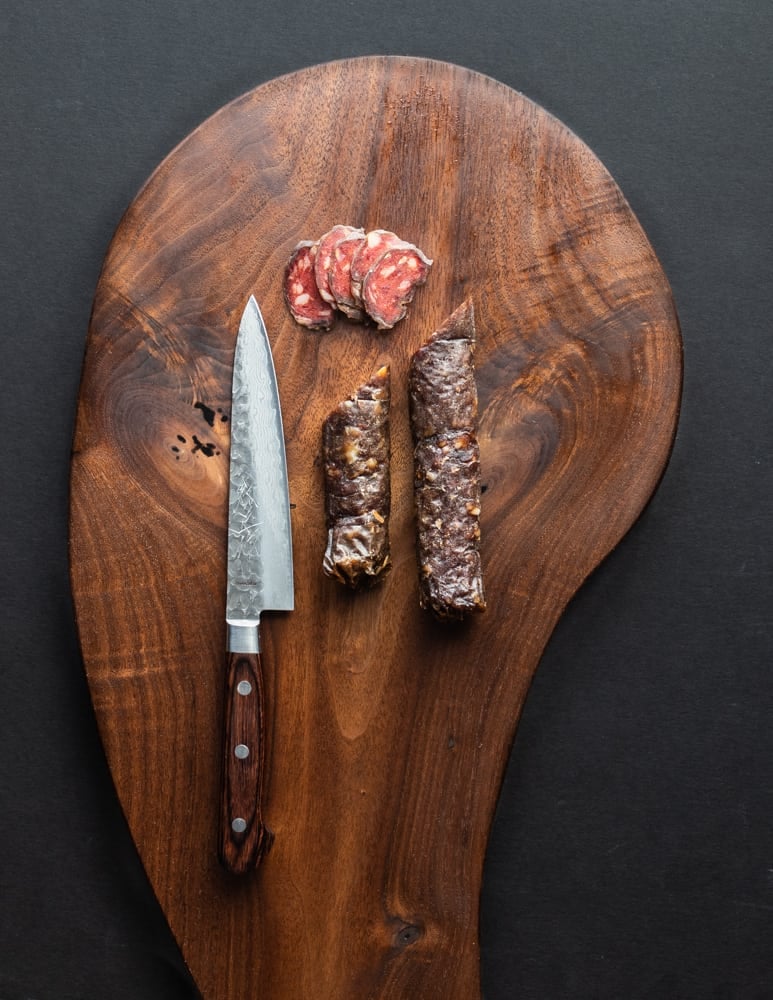I've been making a lot of charcuterie using UMAi DRY casings lately, and, after a month, my first one is done: a Spanish chorizo-style salami recipe made from ground elk and pork flavored with wild fennel seeds.

If you're not familiar, this is a dry cured sausage that's very different from lump Mexican chorizo beef or pork shoulder. It's been years since I made salami, but after my first bite of these, It's going to be a regular thing.

Making salami at home
Making salami at home can be intimidating, and the more you research how people do it at home, the more complicated it can seem. Do I need a dedicated curing chamber? What about humidity controls? What if I do something wrong? Will I die? Generally speaking, salami is pretty safe as it's highly salted, and I think it's good to remember people have been making it in far more primitive conditions than you'll find in most homes.

That being said, my friends at UMAi DRY have a fantastic product that makes crafting salami and whole muscle cures at home so easy a child could do it. All you have to do is make your salami mix, and pack it into their breathable membrane casings.
The casings are the same technology used for their dry-aging bags (that also work like a charm) that I've used for aging whole legs of venison, and making cured meats like my venison biltong and salami from pork shoulder. .
Once the meat is packed into the casings, you allow them to ferment for 24 hours at room temperature (a turned off oven works great) then refrigerate them for four weeks, or until they're dry to your liking. It's the easiest salami I've ever made, and I have two more batches in the works that will be done soon. Take a look at the video and you'll see just how easy it is.

Related Posts on Charcuterie
Lamb, Goat or Venison Prosciutto
References on making charcuterie at home I own
Charcuterie by Micheal Rhulman
Wild Fennel Seed Venison Chorizo
Equipment
Ingredients
Meat
- 4 lbs lean elk or venison
- 1 lb pork fat
Salt and spices
- 45 g salt
- 1 T black pepper
- 1 teaspoon instacure no 2
- 1.5 T wild fennel lightly toasted
- 1 T cayenne
Finishing ingredients
- ¼ cup dextrose
- ¼ cup milk powder Optional, see note
- ¼ cup red wine
- ¼ cup paprika
- ¼ cup bactoferm mixed with 2 Tablespoons distilled or filtered water
Instructions
- Cut the meat and fat into pieces that will go through a meat grinder easily, then chill in the freezer until half-frozen.
- Mix the bactoferm with the water and reserve.
- Cut the UMAi DRY casings into a foot length, or however long you want your salami to be.
- Grind the chilled meat and fat through a ¼ inch die of a meat grinder.
- Toast the fennel and pulse a couple times in a spice grinder. Don’t grind the fennel to powder, just pulse it 2-3 times as you want to see some whole seeds in the finished product. Mix the meat with the salt and spices by hand, then mix in the finishing ingredients: dextrose, milk powder, the bactoferm slurry, and wine.
Fermentation
- Pack the mixture into the UMAi DRY casings, tying off each end with zip ties or butcher’s twine. Put the salami on a baking sheet with a rack, then allow to ferment at room temperature for 24 hours, or until you can notice the color of the meat visibly lighten.
- For fermenting, putting the salami in a still/turned off oven works fine. If you put the salami in the oven, make sure to put a note on the handle so no one turns it on-that won't be fun for anyone.
Drying and finishing
- After 24 hours, remove the salami and place in a fridge for 4 weeks, or until dry to your liking. When the salami are finished, I like to vacuum seal and freeze them until I want to use them, which also refreshes the texture.
- Finished, dried salami can be stored in the fridge for a few weeks, or frozen for long-term storage.


Angie
I’m loving all your recipes! Watching you on tastemade and wondering what brand your grill is??? Also... love the idea of the dill pickle slices on the wild mushroom bruschetta. I own a pickle company!
Alan Bergo
Thanks Angie. The grill is called a Kudu.